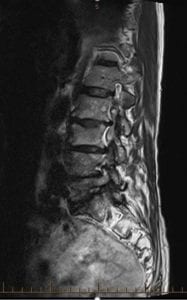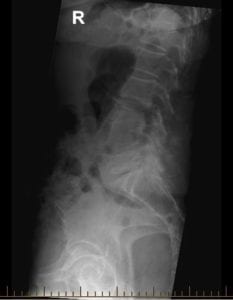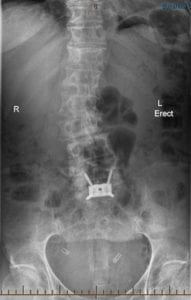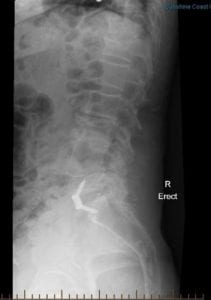Anterior Spine Surgery: a great way to help nerve pain
Written By: Stephen Byrne Neurosurgeon and Complex Spine Surgeon
Recently I had the pleasure of looking after a very fit and active 70 year old lady. She had previously enjoyed free climbing and hiking and had plans to trek Machu Pichu and to Everest Base Camp over the next 2 years! She presented to her GP with worsening pain radiating down the leg in the region of the L5 dermatome (lateral calf and dorsum of the foot) for 6 months. She struggled with getting around the local shopping centre and with some activities of daily living. Long walks became less and less frequent and she gave up many of the activities that she previously enjoyed. Rather than living with her pain, she presented to her GP who organised an MRI scan of her lumbar spine and a nerve injection. The injection helped her pain considerably but only for 3 days. She also tried physiotherapy and had some acupuncture but didn’t obtain lasting relief.
The patient was then referred to me for further management. She recounted the history above and explained her lifetime ambition to experience two of Earth’s wonders. Her neurological examination was significant only for some reduced sensation in the left L5 dermatome and some mild weakness of ankle dorsiflexion (4+/5). Her lumbar xrays showed a severe degenerative lumbar scoliosis and almost complete loss of disc height at L5/S1. Consequently, her MRI scan showed significant compression of her L5 nerve root which appeared to be compressed by the superior aspect of the S1 vertebral body against the L5 pedicle. I discussed her management options with her in detail. These options included soldiering on with pain, taking painkillers, physiotherapy or alternative therapy, more injections or surgery. Ultimately, the patient chose to have an operation and I suggested an L5/S1 anterior lumbar interbody fusion. The aim of the proposed surgery would be to help her presenting complaint only. We agreed that a more limited procedure would be best as she’d be unlikely to return to her previous levels of activity if she underwent a multilevel deformity correction procedure.
Her operation was uncomplicated. Working below the aortic bifurcation and common iliac vessels the L5/S1 disc was removed and replaced with an interbody fusion device in order to ‘jack open’ the space around the L5 nerve root. The operation began at 1130 and she was in recovery by 1300. She was walking that afternoon and was discharged home after one night in hospital. Her pain had resolved and she was off all painkillers after 6 days. She continues to do well on follow up and I have cleared her to trek to Mount Everest and Machu Picchu. She has already returned to hiking and free climbing.
Spine surgery pearls
- Anterior spine surgery is associated with a rapid recovery as it doesn’t involve cutting muscle. It is ideal at L5/S1 as the working space is below the major blood vessels
- The surgeon can discuss the natural history of the condition as well as the role of non-operative and operative treatment and their relative efficacy
- A range of open or minimally invasive treatment strategies are now available and can be tailored to individual patient’s needs

MRI image showing L5 nerve root compression.

Xray showing degenerative scoliosis and obliteration of L5/S1 disc space.


Post operative xrays showing L5/S1 interbody device and restoration of the foraminal height at L5/S1.
